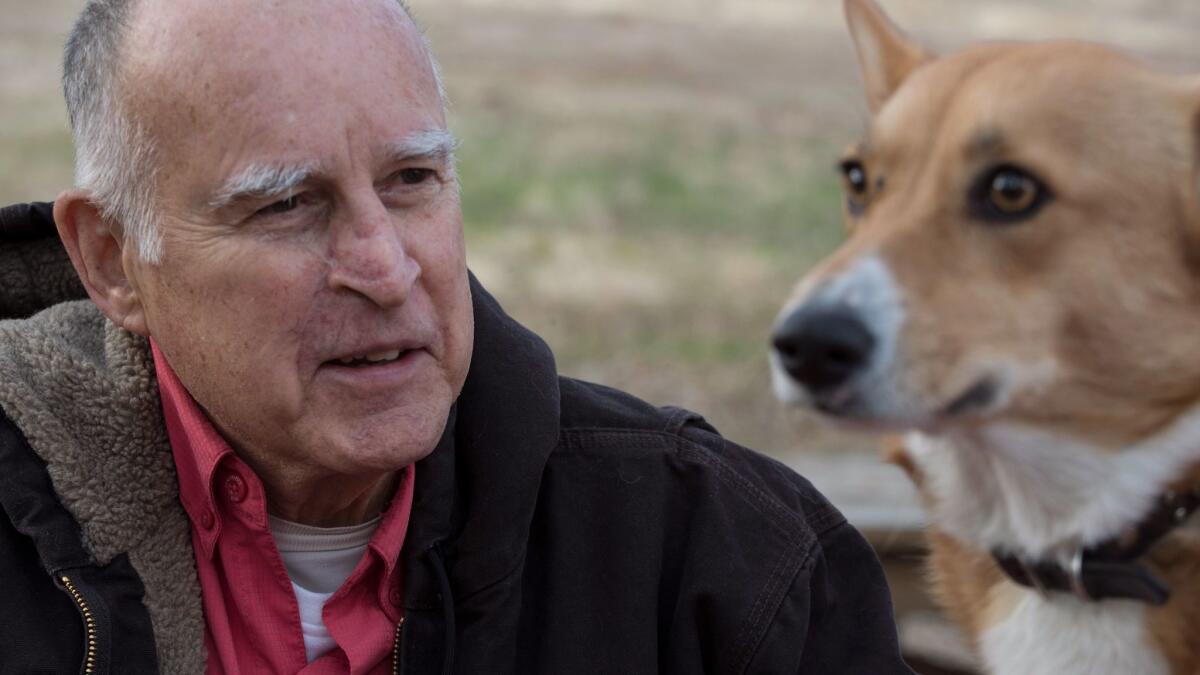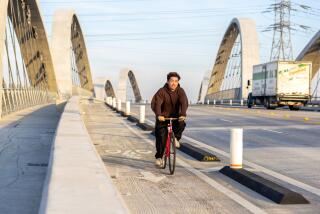Capitol Journal: Gov. Jerry Brown is in danger of becoming remembered for his ‘boondoggle bullet train to nowhere’

- Share via
Reporting from Sacramento — Time is running out for Gov. Jerry Brown to fix two big legacy projects. If he doesn’t, his successor might just dump them in the trash.
Brown has only until the end of the year to clean up and repair his bullet train and water tunnel ventures. He’s trying.
Perhaps we’ll hear more about it in the governor’s final State of the State address to the Legislature on Thursday. Then again, he may decide not to bring up sore subjects.
Brown last week sent his talented transportation secretary, Brian Kelly, to the High-Speed Rail Authority to be its chief executive and try to prevent a train wreck.
Concerning water, the governor has indicated he’s willing to compromise on the proposed twin tunnels in the ecologically fragile Sacramento-San Joaquin River Delta. He’s fishing for support if the project is trimmed to only one tunnel.
These costly projects have been Brown obsessions for two terms in office. And he’ll be remembered for how they turn out, especially the bullet train.
Yes, he’ll also be remembered as a fiscal steward who controlled spending by Democratic legislators. He came to office in 2011 facing a $26-billion deficit. Now there’s a budget surplus. That’s mostly because of the national economic recovery and a hefty soak-the-rich income tax increase Brown pushed. Still, he justifiably earned a reputation as a tightwad.
He also was miserly in his first two terms, 1975 to 1983. Yet, what’s remembered by his detractors is “Gov. Moonbeam.” He acquired that tag by suggesting the state launch a communications satellite.
Brown II is in danger of becoming remembered for his “boondoggle bullet train to nowhere.”
The Los Angeles-to-San Francisco train project, actually inherited from former Gov. Arnold Schwarzenegger, is way underfunded and far behind schedule.
Voters authorized $9 billion in high-speed rail bonds in 2008. The feds kicked in an additional $3.3 billion. And the project currently draws around $600 million annually from cap-and-trade revenue — money generated by selling greenhouse gas emission permits. Private investors haven’t shown any interest.
Meanwhile, costs keep climbing. They were pegged at $64 billion until recently, nearly double what the public was told back in 2008. Then last week, the price tag for laying the initial 119-mile stretch in the San Joaquin Valley was raised by $2.8 billion to $10.6 billion, a 77% increase over the original estimate.
Brown hopes Kelly will bring pragmatism, discipline and a salesman’s touch to the project. They’re traits he showed at the Transportation Agency last year in helping to shepherd a gas tax and vehicle fee increase through the Legislature to pay for highway repairs. Kelly also is an experienced legislative hand, having been a transportation consultant to Senate leaders for 17 years.
Kelly told Times reporter Ralph Vartabedian he intends to “dive in, stabilize [the project] and restore its credibility.”
How? “Being transparent,” he told me. “Get a plan together that’s very credible with legislators and the public. Describe it as frankly as we can. We have to lay out very clearly what the challenges are and what our proposal is. If people read that and view it as credible, they’ll support it. If they don’t, we have problems.”
Yes, government usually has problems when it doesn’t level with the public and fantasizes.
Coverage of California politics »
“One thing the project has always suffered from,” Kelly continued, “is that it has never had all the funding it needed. The challenge is to say with the money we have, here’s what we can do. For additional actions, we’ll have to get more money.”
Don’t expect to get more money from the voters until the train actually starts rolling.
And that could be never if the train’s outlook doesn’t substantially improve before Brown’s successor takes office. Neither of the leading Democratic candidates for governor — Lt. Gov. Gavin Newsom or former Los Angeles Mayor Antonio Villaraigosa — have showed much enthusiasm for this project because of its astronomical costs.
Same for the $17-billion twin tunnels.
Brown has wanted to burrow two 40-foot-wide, 35-mile tunnels under the delta to funnel fresh Sacramento River water into aqueducts headed for San Joaquin Valley farms and Southern California cities. Delta farmers strongly object. Environmentalists worry about destroying salmon runs. Some water districts think it’s not worth the cost.
So Brown finally is dangling one tunnel. That’s better.
Back to the drawing board with little time left.
Brown doesn’t like to talk about legacies, and claims not even to be interested. But that would defy human nature.
“Can you tell me the legacy of Goodwin Knight or Gov. [Frank] Merriam or [George] Deukmejian?” Brown replied sharply recently when a reporter tried to ask a legacy question. “Governors don’t have legacies. That’s my No. 1 proposition.”
Sorry, governor, they certainly do.
The legacy of Brown’s revered father, Pat, was as a great governor and builder who lost a third term bid to Ronald Reagan.
Knight presided over a smooth-running, fast-growing state in the 1950s when kids could go to a public university tuition-free.
Merriam was a depression-era governor who beat Socialist Party member Upton Sinclair, the Democratic nominee, in one of the nastiest election campaigns ever.
Deukmejian built prisons, signed the state’s first ban on assault rifles and pulled state investments out of racially-segregated South Africa, helping to end apartheid.
Jerry Brown’s final legacy is pending. Check back in a year.
Follow @LATimesSkelton on Twitter
More to Read
Get the L.A. Times Politics newsletter
Deeply reported insights into legislation, politics and policy from Sacramento, Washington and beyond. In your inbox three times per week.
You may occasionally receive promotional content from the Los Angeles Times.











